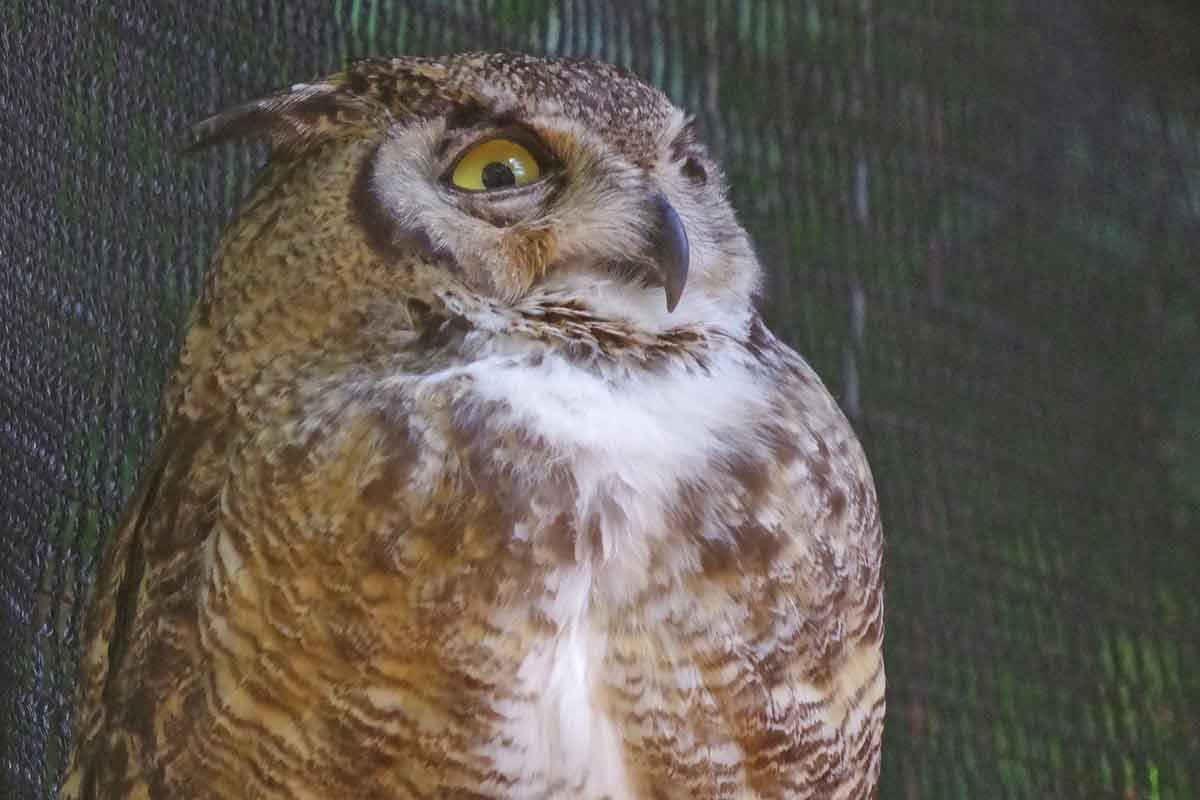
Going on an owl prowl is a great way to experience wildlife like this great horned owl after dark.
Bob Frye/Everybody Adventures
It was the pellets that first gave them away.
We were hiking a trail through the woods of a local park. It’s not rugged by any means, yet the terrain had slowed our gait a bit. It was downhill, but steep, and on this day wet.
At one point, moving slowly beneath some pines to keep from slipping and sliding on the loose bed of needles, we spotted them.
At the base of one tree were a half dozen or so owl pellets.
They’re windows into the diet, if not soul, of these predators of the night.
Most birds have a crop, or pouch where food that’s eaten but not yet digested is stores until it breaks down. Owls do not.
Their food goes directly to their gizzard. Soft tissue – muscle, fat and skin – gets absorbed. Harder material, like bones and fur, does not.
Instead, owls compact it, then regurgitate it in the form of round, dry balls.
Those were what we discovered.
Children the nation over – in schools, summer camps and nature programs – break them down to figure out what the owls ate. The results say a lot about not only the owls, but the prey species common to an area.
We didn’t collect the ones we found, concentrated here below what was obviously a roosting tree.
But we did look for the owls. Several times over the coming weeks, we went on “owl prowls,” or evening hikes, to look for these nocturnal raptors.
Chances of seeing — or better yet hearing – a camouflaged owl or two are pretty good in most places. There is a wide variety of owls across the continent, and most are doing relatively well.
We encountered two kinds in this park.
One was the barred owl. It’s a favorite just because of its distinctive call, which sounds like “Who cooks for you? Who cooks for you all?”
There was one pair in particular that we counted on finding just about every night, in nearly the same spot. They’d call to one another and sometimes to us before winging their way silently through the dusky trees.
Also common, but usually harder to spot, was a great horned owl. One of the most common of owls – its range extends all across America, north into most of Canada and south into Mexico and Central America — it’s the owl that looks most like, well, an owl, or at least the owls of story books.
With big tufts atop its head, large yellow eyes and what appears a perpetual scowl, it looks not only wise, but also slightly disapproving, as if it is struggling to suffer fools in the woods.
Both barred and great horned owls, like all of their kind, are night hunters. They’re uniquely adapted to kill after dark.
They not only have excellent sight and hearing, but their feathers have frayed, rather than crisp, ends. That serves to muffle sound. The result is they can swiftly approach and attack prey without giving away their presence.
Masters of the night, that’s what they are.
An owl prowl – a hike taken around dusk and later — is a great way to study these unique birds, too. State parks, nature centers, bird watching clubs and others schedule them regularly. Usually guided, they’re a great way to get started owling.
But it’s possible to prowl on your own, too.
For starters, look for owls in areas with lots of small prey species, like mice, voles, rabbits and the like. Wood edges along fields and meadows are likely spots.
Pay particular attention to areas where you see hawks. Owls many times hunt the same areas hawks do, just doing it after dark.
Of course, you can also look for pellets. But don’t overlook “whitewash,” too. That’s the chalky white splashes of excrement the birds leave on trees and branches, often just below their roosts. Find those signs and you know an owl is nearby.
Pack a good light when heading out. This isn’t for spotting owls, necessarily. Shining a bright light on an owl is in fact a good way to agitate it and convince it to fly off. But you need some light to see when negotiating trails after dark.
It pays to be quiet, too. You’re not going to walk the woods without an owl knowing it. Their hearing is just too sharp. But they’re more likely to remain still if you’re quiet than if you’re tromping through the woods.
At the same time, listen. Owls are naturally camouflaged. They’re designed to be hard to spot. But if you listen for them, you’ll often hear one before – or if – you see it.
Listen to recordings of the owls in your area before heading out, too. Then, whether you see the owl or not, you may be able to tell what kind it was.
Good binoculars – even spotting scopes — are important for when opportunities to see birds do arise. You’ll be out in low light conditions, so get binoculars with larger lenses. They brighten your view considerably.
There’s no guarantee you’ll come across an owl, of course. But they’re out there, in lots of places, often in good numbers.
Taking a night hike to look for them is an awesome way to explore fields and forests in a way most never do.
And now is a great time to do it. Owls give birth early in the year, so there are lots of young owls out there at this moment, less adept at hiding themselves. They’re generally easier to find.
So go prowling.
Want to see more? Check us out on Facebook, Twitter and Instagram.








